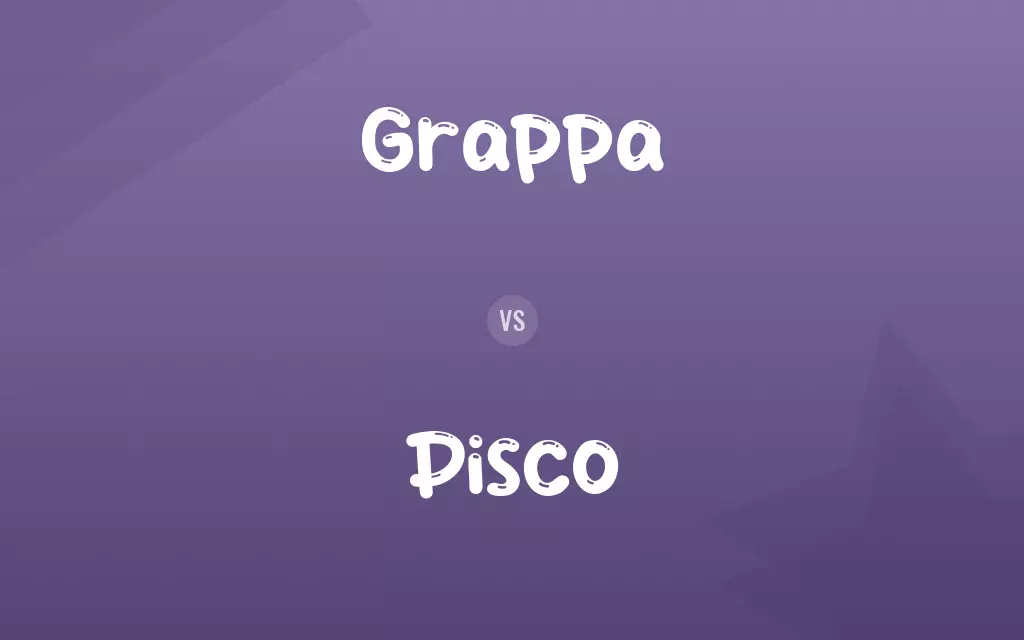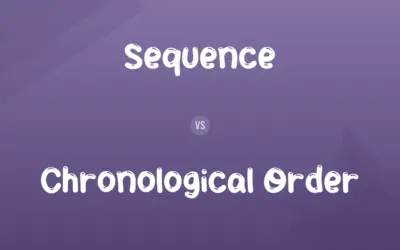Grappa vs. Pisco: Difference and Comparison
Edited by Muazma Batool — By Muneeza Rehman — Updated on February 26, 2024
Grappa is an Italian brandy made from pomace, while Pisco is a South American grape brandy, distinct in origin and flavor profile. Grappa emphasizes heritage, Pisco tradition.

Difference Between Grappa and Pisco
Grappa, originating from Italy, is a potent brandy distilled from pomace—the leftover grape skins, seeds, and stems from winemaking. Pisco, on the other hand, hails from Peru and Chile, made exclusively from distilled grape wine, showcasing a clear distinction in base ingredients and geographic origin.
Muneeza Rehman
Feb 26, 2024
The production process of Grappa involves fermenting pomace, emphasizing the utilization of the entire grape harvest, reflecting Italian ingenuity in winemaking byproducts. Pisco's production, however, focuses on the purity and quality of the grapes themselves, distilled from fresh grape wine, highlighting the South American dedication to grape quality and flavor.
Muazma Batool
Feb 26, 2024
Grappa's flavor is robust and earthy, often influenced by the variety of grapes and the specifics of the pomace used, mirroring Italy's diverse viticulture. Pisco offers a broader range of flavors, from fruity and floral to smooth and subtle, indicative of the grape varietals chosen, influenced by the terroirs of Peru and Chile.
Muneeza Rehman
Feb 26, 2024
Traditionally, Grappa is consumed as a digestif, enjoying a cultural status that celebrates its heritage and the warmth it brings to gatherings. Pisco, celebrated through the iconic Pisco Sour cocktail, enjoys a versatile role in mixology, representing South American vibrancy and hospitality.
Nolan
Feb 26, 2024
Grappa and Pisco both enjoy protected status, with Grappa protected by European law and Pisco by Peruvian and Chilean denominations of origin, underscoring their cultural and geographical significance. This legal recognition not only preserves their traditional methods of production but also honors their rich histories.
Muneeza Rehman
Feb 26, 2024
Grappa vs. Pisco Comparison Chart
Base Ingredient
Pomace (leftover grape parts after winemaking)
Distilled grape wine
Muazma Batool
Feb 26, 2024
Grappa vs. Pisco Definitions
◉Grappa
Grappa is a distilled spirit made from pomace in Italy.
After dinner, we enjoyed a glass of Grappa to aid digestion.
Muazma Batool
Feb 26, 2024
◉Pisco
Pisco is a grape brandy from Peru and Chile.
I used a high-quality Pisco to make the Pisco Sour cocktails for the party.
Muneeza Rehman
Feb 26, 2024
◉Pisco
Features a diverse flavor palette.
This Pisco is particularly floral, reflecting the grape varietal used.
Muazma Batool
Feb 26, 2024
◉Grappa
Often served as a digestif.
Grappa is traditionally consumed at the end of a meal.
Olivia
Feb 26, 2024
◉Pisco
Made exclusively from distilled grape wine.
The purity of the grape wine is crucial for crafting premium Pisco.
Muneeza Rehman
Feb 26, 2024
◉Grappa
Protected by geographical indications.
Authentic Grappa must adhere to strict Italian production standards.
Muneeza Rehman
Feb 26, 2024
◉Pisco
Holds denominations of origin in Peru and Chile.
Pisco's quality is protected by its geographical indication.
Muneeza Rehman
Feb 26, 2024
◉Grappa
It varies in flavor based on grape type and region.
This Grappa has a distinct earthy note, characteristic of its regional grapes.
Muneeza Rehman
Feb 26, 2024
◉Pisco
Central to South American mixology.
Pisco adds a unique flavor to traditional South American cocktails.
Elijah
Feb 26, 2024
◉Grappa
An Italian brandy distilled from the pomace of grapes used in winemaking.
Muneeza Rehman
May 03, 2023
◉Pisco
A liquor distilled from grapes (a brandy) made in wine-producing regions of Peru and Chile. It is the most widely consumed spirit in Argentina, Bolivia, Chile and Peru.
Muneeza Rehman
May 03, 2023
◉Grappa
(uncountable) An Italian grape-based spirit of between 80 and 100 proof, made from the distillation of pomace.
Muneeza Rehman
May 03, 2023
Grappa vs. Pisco Frequently Asked Questions
What is Grappa?
Grappa is an Italian brandy distilled from pomace, known for its robust flavor and traditionally served as a digestif.
Muneeza Rehman
Feb 26, 2024
What makes Grappa unique?
Grappa's uniqueness comes from its distillation from pomace, reflecting a zero-waste approach to winemaking, and its earthy flavor profile.
Leo
Feb 26, 2024
Can Grappa and Pisco be used interchangeably in cocktails?
While both can be used in cocktails, their distinct flavors may alter the taste profile of traditional recipes.
Jonathan
Feb 26, 2024
How are Grappa and Pisco different?
The main differences lie in their base ingredients—Grappa from pomace and Pisco from grape wine—and their origins, Italy versus Peru and Chile.
Muneeza Rehman
Feb 26, 2024
How should Grappa be served?
Traditionally, Grappa is served neat in a small glass as a digestif after meals.
Lucas
Feb 26, 2024
What is Pisco?
Pisco is a South American grape brandy from Peru and Chile, celebrated for its versatility in cocktails, particularly the Pisco Sour.
Muazma Batool
Feb 26, 2024
Why is Pisco significant in South American culture?
Pisco holds a significant place due to its history, role in national drinks like the Pisco Sour, and its reflection of the regional grape diversity.
Olivia
Feb 26, 2024
Are there different types of Grappa?
Yes, Grappa can vary greatly depending on the types of grapes used, the production region, and whether it's aged.
Muneeza Rehman
Feb 26, 2024
What does the protected status of Pisco entail?
The protected status ensures that Pisco is produced within specific regions of Peru and Chile according to traditional methods.
Muneeza Rehman
Feb 26, 2024
Is there an age requirement for Grappa?
While not all Grappa is aged, those that are offer a more complex flavor profile.
Olivia
Feb 26, 2024
What are the main types of Pisco?
Pisco types include Puro (single grape variety), Aromáticas (aromatic grapes), Mosto Verde (partially fermented grape must), and Acholado (blend of grapes).
Muneeza Rehman
Feb 26, 2024
How does the production process affect the flavor of Grappa and Pisco?
The production processes, including the base ingredients and distillation methods, directly influence the distinct flavor profiles of Grappa and Pisco.
Muneeza Rehman
Feb 26, 2024
What is the best way to enjoy Pisco?
Pisco can be enjoyed neat, on the rocks, or as the base spirit in a variety of cocktails, with the Pisco Sour being the most iconic.
Elijah
Feb 26, 2024
Can Grappa be made outside of Italy?
Authentic Grappa must be produced in Italy, though similar spirits may be made elsewhere under different names.
Olivia
Feb 26, 2024
What's the significance of the grape variety in Pisco production?
The grape variety significantly influences the flavor and aroma profile of Pisco, with each variety offering unique characteristics.
Henry
Feb 26, 2024
Content Creators
Written by
Muneeza RehmanAt Comparisons.wiki, Muneeza skillfully navigates the vast sea of information, ensuring clarity and accuracy as the lead content editor. With a keen eye for detail, she curates every comparison to enlighten and engage readers.
Edited by
Muazma BatoolAs a content editor, Muazma Batool is not just a grammar guru but a creative mastermind who breathes life into every word. With an eagle eye for detail and a passion for storytelling, she transforms bland text into engaging content that captivates audiences and drives results.

































